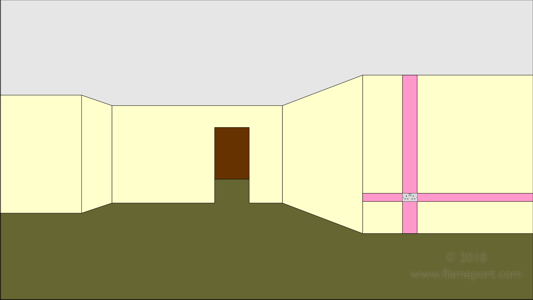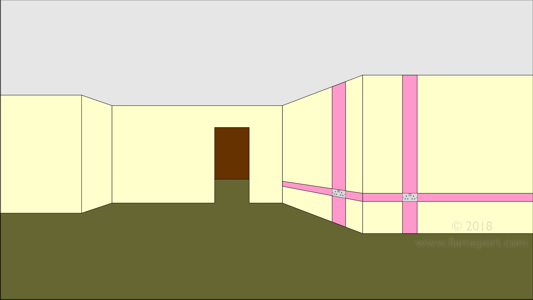Wiring Regulations - Cable Zones
When installing cables in walls and those cables will be concealed, BS7671 requires that they are installed only in specific zones.
These were called 'safe zones' in the 17th and earlier editions, now renamed 'prescribed zones' in the 18th edition.
The actual zones have not changed between editions.
The Video
This video covers the prescribed zones and the regulations for them. All walls have some defined areas where cables can be installed, and installing a socket, switch or other item which has cables connected to it will create additional zones vertically and horizontally from the item.
Top of walls
The first zone is a 150mm wide strip at the top of any wall where it meets the ceiling.
Shown here in pink, this applies to all walls, regardless of whether any electrical items are installed on the wall.
Cables in this zone can be concealed behind coving if desired, which may avoid the need to cut a channel into the wall.
Corners between two walls
 Another zone exists where any two walls or partitions join at an angle.
Another zone exists where any two walls or partitions join at an angle.
These are 150mm wide on each of the adjoining walls and apply to both internal and external corners.
Cables in these zones do not have to be connected to anything on the wall or in the room.
Zones formed by installing an electrical accessory
 Where an electrical accessory is installed on a wall and cables are connected to it, a zone is formed vertically and horizontally from the accessory.
Where an electrical accessory is installed on a wall and cables are connected to it, a zone is formed vertically and horizontally from the accessory.
This example shows a socket outlet, cables connected to the socket can be installed anywhere in the pink zones.
Zones do not extend around corners or onto adjacent walls.
Two or more electrical accessories
 Installing a second socket outlet creates additional zones so that cables could be continued onto a second wall.
Installing a second socket outlet creates additional zones so that cables could be continued onto a second wall.
These zones only apply to cables actually connected to the accessory (the sockets in this example).
Doorways and the other side of walls
 This example shows a light switch on a wall with a doorway. Zones are created vertically and horizontally from the switch.
This example shows a light switch on a wall with a doorway. Zones are created vertically and horizontally from the switch.
Note that they do not extend beyond the corner, or past the doorway.
As with the previous socket example, these zones only apply for cables connected to the light switch.
If the wall is less than 100mm thick and it is possible to determine the location of the switch or other accessory from the other side, these zones extend to the other side.
In this example the doorway makes it easy to identify the location of the switch from the other side, so the zones extend onto the other side of the wall in the red room.
Illustration of all zones
 The pink areas in this diagram shows the zones for both the room and those created by installing sockets and switches.
The pink areas in this diagram shows the zones for both the room and those created by installing sockets and switches.
If it is necessary to install cables outside of these zones, they must be of the armoured type, installed in steel conduit, steel trunking or have mechanical protection from nails and screws.
Note that cable capping is NOT mechanical protection from nails. Capping is secured to the wall with nails, and those nails pass through it easily.



